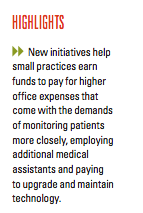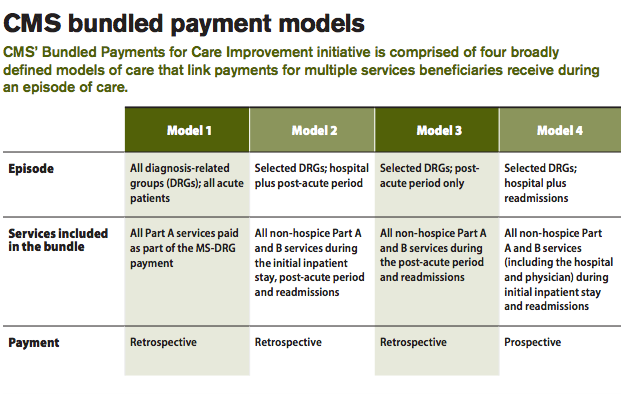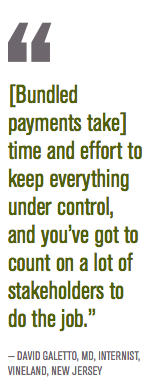Article
How bundled pay brings physicians greater risks and rewards
Author(s):
Many experts view bundled payments as a critical part of cutting costs and reforming healthcare.

As physicians deepen their involvement in the shift to value-based care, they are beginning to grapple with the sweeping changes that bundled payment initiatives will bring to the way they practice medicine.
David Galetto, MD, is an internist and one of five members of a private practice in Vineland, New Jersey. Galetto commits 25% of his time to Inspira Health Network, which has three acute care hospitals in southern New Jersey. There he serves on the committee overseeing care redesign and attends to Medicare beneficiaries who are part of a bundled payment initiative. He spends the rest of his time seeing patients at his group practice, which is also involved in a patient-centered medical home initiative.
"Am I working harder than I used to? Oh my God, yes," says Galetto.
He says that at Inspira Health, the bundled payment program has increased his workload, adding tasks from meeting with peers to discuss implementing best practices for care design to following up with doctors, specialists, case managers, social workers and surgeons–all in an effort to make sure patients don't stay in the hospital longer than necessary.
"It takes time and effort to keep everything under control, and you’ve got to count on a lot of stakeholders to do the job,” Galetto says.
As the bundled payments model evolves, it will also provide an opportunity for physicians in independent practice to take the lead in establishing a direct relationship with the payer, predicts Tom Campanella, JD, associate professor of health economics and director of the Health Care MBA program at Baldwin Wallace University in Berea, Ohio. He adds that the practice would then negotiate a facility fee with the hospital (if applicable) and the other provider stakeholders.
There will be more risks and rewards for physicians under this approach, Campanella says, but the long-run payoff–which includes enhancing their ability to stay independent–would make it worthwhile.
"As they drive quality metrics and cost-effective initiatives, physicians will soon realize that they've never had such a golden opportunity to take a leadership role in improving healthcare across the board. That’s a great position to be in," Campanella says
Galetto agrees, noting that the model will be critical in shaping the way doctors approach their jobs because it allows their opinions to carry greater weight in the decision-making process.

"Over the years, doctors have been frustrated because when we wanted to make changes in a particular care process, and if we failed to effect change, in some instances it was because stakeholders were not all at the table to come to a consensus, or individual stakeholder interests were not aligned," Galetto says.
Even while there is the burden of additional work, many physicians at small practices are actively engaged in new initiatives to boost revenues. All five physicians at Galetto's private practice are involved in Inspira Health's bundled payment initiative.
April Venable, director of Population Health Decision Support at Inspira Health Network, who invited Galetto to join the hospital's bundled payment efforts, says once physicians attended a series of open sessions to learn more about the program, it was easy to get them to enroll. "Their billing and payment processes do not change–it's just an extra payment to them every six months if their cost has improved," says Venable.
Another advantage to the new payment initiatives is they can help small practices earn income to pay for higher office expenses that come with the need to monitor patients more closely, such as additional medical assistants and upgrades to technology, Galetto says.
Facing the future
As a result of new bundled payment initiatives, physicians will encounter the following, according to Campanella:
- The need for better care coordination among stakeholders involved with the bundled payments.
- The challenge of improving patient compliance so as to improve the quality/outcome aspect to most bundled payment methodologies.
- Greater financial risks and rewards, especially as bundled payments continue to evolve.
- The need to understand the details of the bundled payment contractual relationship with the payer or the hospital if the physician is sub-contracting with them, especially as it relates to risks, rewards and quality/outcome requirements.

The growth of bundled payments coincides with the Centers for Medicare & Medicaid Services' (CMS) looming Merit-based Incentive Payment System (MIPS) and Alternative Payment Models (APMs), designed to replace Medicare's Sustainable Growth Rate physician payment formula.
Campanella says the goal of bundled payment initiatives and MIPS/APMs is to encourage physicians to provide better care, not just more care.
The bundled payment model is being applied to more episodes of care, as the traditional practice of charging separately for services such as a surgical procedure, post-operative care, and physical therapy– which generates multiple claims from multiple providers–is replaced with a model that compensates care teams with a fixed dollar amount under one bundled payment.
For example, Horizon Blue Cross Blue Shield of New Jersey recently announced a bundled payment initiative with University Hospital of Newark for pregnancy and delivery. In another example, St. Vincent Charity Medical Center in Cleveland, Ohio, will participate in the Pacific Business Group on Health Employers Center of Excellence network to provide a bundled payment program for bariatric surgery.
CMS is experimenting with four bundled payment initiatives under its Bundled Payments for Care Improvement (BPCI) program. In April it launched the Comprehensive Care for Joint Replacement model, which is the agency's first mandatory bundled payment initiative. It requires that acute care hospitals be held accountable for the cost and quality of care for Medicare beneficiaries that have hip and knee replacement, from surgery to recovery.
BPCI Model 1
Since April, 2013, Inspira Health Network has participated in BPCI Model 1. Under this initiative, an episode of care is defined as the inpatient stay in an acute care hospital. Medicare pays the hospital a discounted amount based on the payment rates established under the Inpatient Prospective Payment System (IPPS), a system of payment for the operating costs of acute care hospital inpatient stays. (Under the IPPS, each case is categorized into a diagnosis-related group [DRG] and each DRG has a payment weight assigned to it, based on the average resources used to treat Medicare patients in that DRG.)

Another feature of BPCI Model 1 is that Medicare continues to pay physicians separately for their services according to the Medicare Physician Fee Schedule.
While Galetto is not employed by Inspira Health, he credits the efforts of its care teams in aligning provider incentives with rewards for measures that cut costs while improving patient outcomes as the catalyst for cost reductions ranging from 7% to 11% per admission, depending on the time period being calculated.
The initiatives include performing fewer unnecessary tests, collaborating with care teams to follow up with patient care, including more information related to the patient's care in the patient's electronic health record, and educating staff members on the latest recommendations from the American Board of Internal Medicine's Choosing Wisely initiative.
Between April 2013 and June 2015, Galetto says, the hospital has realized savings of $9 million. Part of that is attributed to the decline in length of stay and reduced use of the intensive care unit ($2.6 million), a reduction in the general length of stay at the hospital's acute care unit ($2.6 million) and emergency department cost reductions ($610,000).
"Many of the cost-cutting practices that we've implemented would never have occurred had it not been for our involvement in the BPCI initiative," Galetto says.
He adds that a lesson Inspira has learned from using the bundled payment model is that change comes with a price. "If there's going to be a change in the way the healthcare system delivers care, those changes must be aligned with financial incentives," Galetto says.
He notes also that the goals are twofold: physicians can earn dollars based on achieving either: 1) performing better than they did in the prior year on a similar case (for example, heart failure last year compared to heart failure this year), or 2) reaching the best practice level for that DRG which is the lowest 25th percentile in the state of New Jersey.
"Physicians who have enrolled in the BPCI program at Inspira Health have received payments every six months depending on how many patients they treat and whether they reduced costs without compromising quality," Galetto says.
Most physicians receive between $1,000 and $10,000 each payment period. The largest payment to an individual physician has been $13,000 in a given six-month time period. "That's enough to make doctors want to improve their practices and contribute to better outcomes for their patients," Galetto says.
As CMS continues to promote cost cutting measures, the agency views bundled payments as a critical part of healthcare reform. In 2015, for the first time in the history of the Medicare program, the U.S. Department of Health and Human Services set explicit targets for alternative payment models and value-based payments. These included a goal of tying 30% of fee-for-service (FFS) Medicare payments to quality or value through alternative payment models such as accountable care organizations (ACOs) or bundled payment arrangements by the end of 2016, and tying 50% of payments to these models by the end of 2018.
BPCI Model 2
Like many orthopedic surgeons, Michael Fehm, MD, who is one of eight private practice physicians at Excel Orthopaedic Specialists in Boston, Massachusetts, says he was attracted to the idea of participating in the BPCI Model 2 program because he saw clinical and financial opportunities and wanted to experiment with new care plans and protocols before a bundled payment model became mandatory.
While continuing to see patients at Excel, in 2014 Fehm joined Ortho New England Group LLC, which includes four orthopedic surgeons who are participating in BPCI Model 2.
Under Model 2, Medicare continues to make fee-for-service payments to providers and suppliers furnishing services to beneficiaries in care episodes. The total expenditures for a beneficiary’s episode is later reconciled against a bundled payment amount (the target price) determined by CMS. Medicare payments reflect the aggregate performance compared to the target price.
Fehm likes that the arrangement enables Ortho New England to receive critical
patient data from Medicare, including the cost of care during an episode. For example, Fehm has access to information that shows how many days the patient spent in rehab, the rehab charges and how many visits the patient received from a visiting nurse or secondary consultations from other providers.
“The data helps me feel empowered to make better decisions to improve patient care,” says Fehm. He has performed roughly 100 surgeries, including joint replacements and hip fracture repairs, during the past 12 months on Medicare patients who are included in the BPCI Model 2 initiative.
Fehm says he’s learned that the model enables surgeons to keep tight control over a patient’s care. As a result, he and his partners now are paying more attention to discharge planning, and referral patterns are starting to change as additional data becomes available.
Understanding how his patients are treated after surgery is critical, because Ortho New England is responsible for the Medicare beneficiary’s inpatient stay in an acute care hospital, as well as their post-acute care and all related services during the episode of care, which ends 30 days after hospital discharge.
“The data allows us to look at our own performance and the performance of secondary providers such as rehabilitation facilities and home therapy and nursing groups,” Fehm says. “Having that data helps us work to raise the bar on performance and quality from all angles. It has empowered us to better advocate and care for our patients.”
The risk of failing to improve patient care is real, but sometimes a patient’s health is beyond the control of physicians. For example, last year one of Fehm’s hip replacement patients developed a post-operative GI bleed following the surgery. The patient required a 10-day ICU stay and multiple upper endoscopies.
While the patient’s hip replacement was straightforward, Fehm says, his overall medical course was complicated, and with the complications came higher costs.
“A large percentage of these costs are assumed by the provider participating in the BPCI. There is a large risk, and not all factors can be controlled” Fehm says. “It’s hard to imagine taking care of a patient and then ending up having to pay.”
Fehm adds that most hip fractures occur in patients with multiple medical conditions, and these patients require more in-hospital and post-discharge care. “On average every hip fracture episode that we’ve attended to has cost this program several thousand dollars, money that must be made up by taking good care of our healthy elective patients and having excellent outcomes in that population,” Fehm says.
Knowing that there’s a financial penalty if patients have complications or are readmitted to the hospital motivates Fehm to watch patients more closely. “I care specifically that patients are better educated to minimize risks post-operatively, such as deep vein thrombosis, infection, constipation and urinary retention,” Fehm says.
He adds that preventing readmissions and avoiding complications will make this Medicare initiative a success, both in its effort to improve care and to cut costs. “The financial implications are real, and in this real-world scenario it has helped us better improve the delivery of care we provide for patients. This is the primary objective set forth by Medicare and I believe we are better now at fulfilling that goal,” Fehm says.
Bundled payments
for dialysis patients
Gurdev Singh, MD, an internist and nephrologist is participating in yet another bundled payment model. In October, 2015, Southwest Kidney Institute, a private practice with 53 nephrologists based in Phoenix, Arizona, teamed with dialysis services provider Davita HealthCare Partners Inc., and Banner Health, a nonprofit health care system, to launch an End Stage Renal Disease Seamless Care Organization (ESCO) in Phoenix and Tucson.
Designed by the Center for Medicare & Medicaid Innovation (CMMI) the ESCO is a kidney disease-specific ACO. As part of the ESCO pilot, CMS tracks both cost and quality of care, and benchmarks it against average cost per patient for prior years, explains Singh, who is vice president of finance at Southwest Kidney Institute.
“There is a great amount of risk involved in this bundled payment model,” says Singh, who is spearheading the bundled payment initiative. Any savings generated compared to the fixed benchmark will be shared between CMS and the ESCO participants. However, at the end of the year, if the cost to treat a patient is higher than the CMS benchmark, ESCO participants will pay a penalty.
Noting that the current FFS-based healthcare delivery model is not sustainable, Singh says bundled payments for dialysis patients prompts nephrologists to find ways to improve quality and reduce patient expenses through optimal use of medical services, dialysis services, drugs and hospitalizations. This requires creative solutions to promote patient engagement and education.
“Bundled payments have changed the way physicians approach care delivery. For example, physicians have to increase resources to enhance patient education around their care, coordinate care delivery among patients and providers and impress upon patients the importance of controlling comorbidities to improve their outcomes,” Singh says.
Medication adherence and consistent attendance at dialysis sessions are top concerns because skipping medications and delaying dialysis treatments could worsen a patient’s condition, leading to hospitalization and higher care expenses. Finding ways to address these issues is important. Research shows that a dialysis patient can cost anywhere from $72,000 to $100,000 per year.
Another challenge involves the timing of payments. To support the initiative, the organization has had to invest time and money in infrastructure and support services. Singh says Southwest Kidney’s costs have increased 10% since the ACO began. However, any reimbursement related to the success of the program is delayed by about 15 to 18 months.
Although Singh says it’s too early to tell what lessons he’s learned from the program, he predicts that the bundled payment model is here to stay and will get better over time.
“We believe that the quality of care will improve and the cost will go down with bundled payment models as long as physicians are reimbursed adequately for additional time and costs associated with achieving the goals,” Singh says. “This will create a win-win for all parties involved – patients, providers and payers.”





